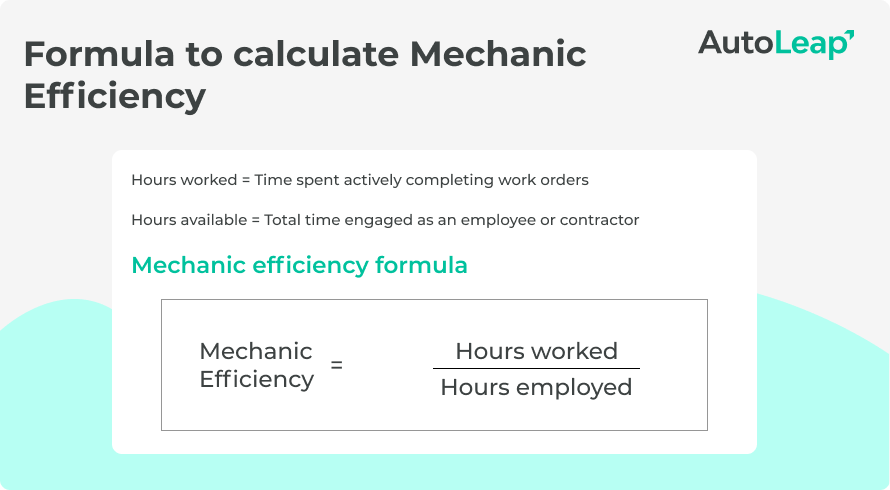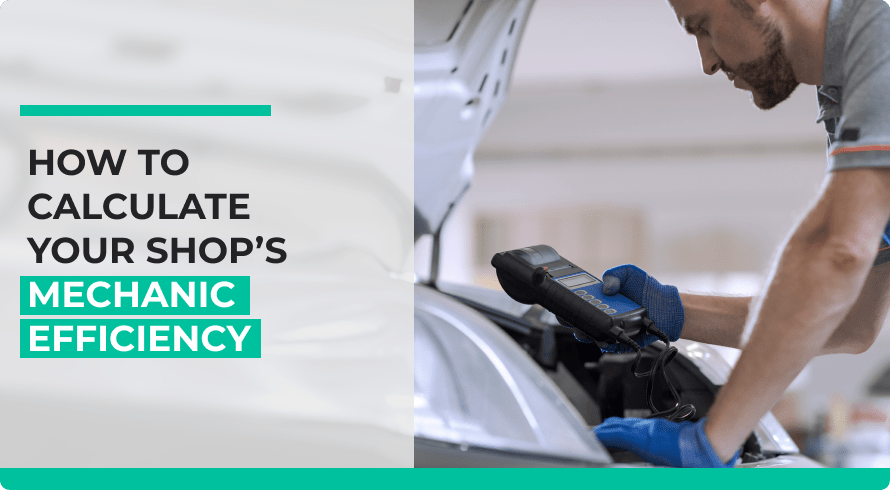Whether it’s a slow season or one of the busiest times of the year, there’s no time to pause and get complacent! Your technicians will spend the same amount of hours at the shop regardless. Therefore, it’s up to you to find the perfect balance between a mechanic’s work capacity in a day and their ability to complete tasks within the allocated time.
Finding that balance is integral—after all, your shop productivity and revenue depend on it! According to a survey by Ratchet+Wrench, less than a third of the percent of shop owners had technician productivity levels of 90%+ while the industry benchmarks for efficiency view 130-150% as good starting points.

Before we cover how to calculate your shop’s mechanic efficiency—it’s important to have a clear definition and understanding of what it refers to! So let’s get into the definition of technician efficiency, understand how to calculate it and look into the ways you can bridge the gap between your current efficiency level and the capacity of your shop.
Understanding technician efficiency
Technician efficiency can simply be defined as how quickly work is completed once a job starts. It is measured by the actual time it took to fulfill a task while compared to the estimated average hours for a similar job.
Simultaneously, it’s important to understand technician productivity. This performance measurement will help you set realistic expectations and understand the average time your technicians require to complete tasks. Technician productivity can be defined as how much work is produced within a given time period—for instance, how much of a mechanic’s day went into billable time to complete tasks versus unapplied time spent in tasks such as traveling. For any shop, it’s important to ensure you’re getting the best labor hours!
However, whether it’s efficiency or productivity—it’s important to go beyond definitions and ensure you have a calculated figure. This helps in creating a clear understanding of your current level of efficiency and keeping an eye on any changes.
How can you calculate mechanic efficiency?
The easiest way to understand mechanic efficiency is by looking at the total number of hours worked by your technician, dividing this number by their actual hours. Multiply this figure by 100 and you have a percentage showing how efficient your technician performance is!

Your goal should be to get this figure as close to 100% as possible. The best way to do that is reduce the hours taken for administrative tasks and reduce lost time that could have instead gone into boosting the shop’s level of productivity!
However, this formula can only provide you a surface level figure of efficiency in your shop. Use of further metrics can help you build your team and understand the actual capacity your auto repair shop has the potential for! Some more metrics to keep in mind include:
- Utilization rate: This formula uses the total number of billable hours worked by an employee, dividing by their total hours available. This expresses how much of their time goes directly into revenue generating work.
- Mean time to complete (MTTC): MTTC calculates the average amount of time that elapses between an issue occurring to the task being completed (includes scheduling, repair and billing time). This will help in identifying any bottlenecks that may be slowing down your technicians’ efficiency when completing tasks.
- Average labor rate: This calculates every cost associated with an employee and divides it by the number of hours worked by the employee. This is especially important when considering the business outputs of hiring more qualified technicians who may expect higher pay.
- Jobs completed per technician: This jobs completed metric is essential for shop owners. It helps you to stay aware of who your most qualified technicians are and each mechanic’s contribution to the overall efficiency of the company.
- Shop capacity: Sometimes it isn’t your technician who isn’t productive. Instead, it’s the production capacity of your shop that’s limited! To understand this dilemma, shop capacity measures the maximum output that can be achieved by your current level of equipment.
Once you’ve calculated some basic statistics to understand where your shop currently stands, it’s important you don’t get lost in the rabbit hole of numbers and calculations. Accurate data is essential when calculating efficiency, and reporting feature of AutoLeap ensures that completed jobs are documented with precision, helping shop owners measure and optimize their mechanics’ performance.
Ways to boost productivity in your shop’s workspace
- Hire the right people: When figuring out which mechanics to hire, it’s important to have an idea of their skill levels and efficiency. Skilled technicians with more experience may prove expensive when calculating labor costs, but generally correspond with a higher level of productivity!
- Provide the right equipment: Making sure your technicians have the right equipment and stocked workstations will build the capacity of your shop while reducing any interruptions or distractions like finding the right tools. Once distracted, it can take up to 25 minutes of non-productive time for technicians to regain their focus. For that reason, it’s important to stay in the zone!
- Conduct digital vehicle inspections (DVI): In such a fast-paced world, it’s important to embrace technological advancements. DVI is one of those changes that can help your technicians smoothly communicate with any customer! A digital vehicle inspection allows your technicians to send pictures and videos to customers. This helps them keep track of any work being done, provide timely proof of repairs, and speed up the service process.
- Streamline customer approvals: Setting up an automated approval process allows customers to provide digital signatures from their own devices. This helps reduce paperwork, minimizes data entry,and ensures there’s less lag time between generating an estimate and starting the job.
- Create a healthy work environment: Maintaining a positive business culture makes all the difference. To create this positive environment, express gratitude. Get your technicians involved by turning to them for ideas and input. These moves will make them feel more valued, important, and give you a new perspective when making decisions.
- Set clear KPIs: Establishing clear KPIs for your technicians to aim for and a high performance bar can help your team set goals to work towards. Along with boosting their productivity, KPI benchmarks will give you measurable business goals to track.
- Use effective marketing: If customers aren’t coming through your doors, then you will struggle to meet KPIs goals. This is true regardless of your shop’s capacity or your technicians’ capabilities. To overcome this, leverage effective marketing tactics. These tactics can help you boost the amount of business coming in. As a result, you can remain profitable even in slow seasons.
- Use a shop management system: Shop management software helps you cut down on tasks that slow down mechanic work! Become more efficient ordering parts, handling invoices, calculating estimates and assigning tasks to your technicians.
Closing Thoughts
Overall, you may notice fluctuations in your technician efficiency but it’s important to not be disheartened if it’s lower than you expected. There’s always ways to work on your shop’s performance and build up your team—keep testing and find what works best for your business!








